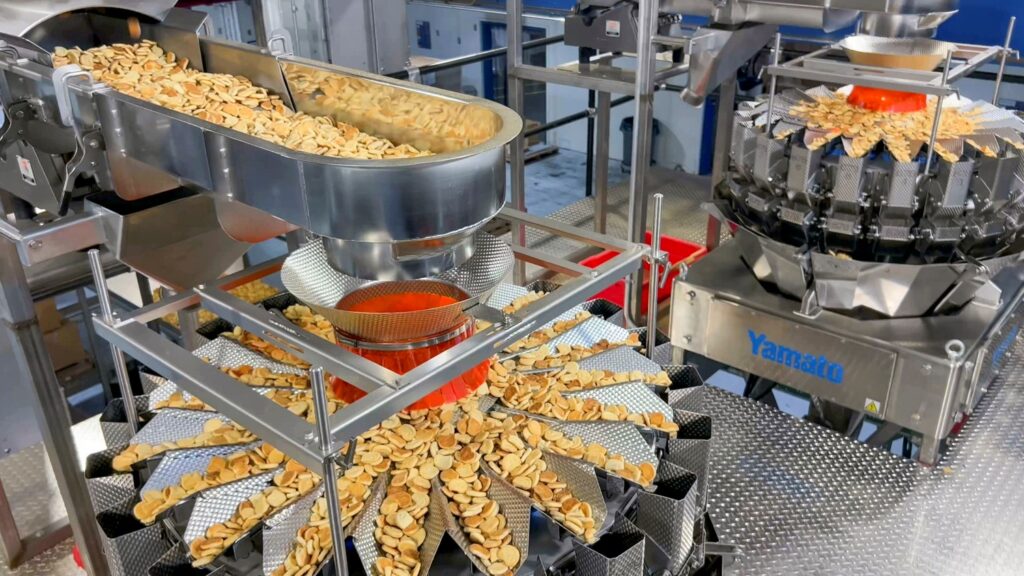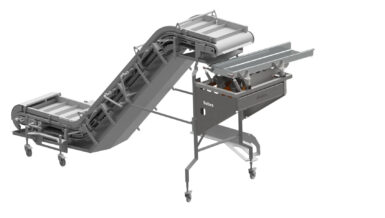A comparative analysis is presented, drawing parallels between electromagnetic feeders and alternative technologies–particularly bucket elevators, belt conveyors, and mechanical vibratory feeders–to emphasize the superiority of electromagnetic feeders for scale feeding.
Importance of Scale In-feed Systems in Industrial Operations
In diverse industrial settings, precise control and maintaining a consistent material flow are fundamental requisites. Scale feeding systems are purposefully designed to fulfill this role, ensuring a controlled and dependable on-demand supply of bulk material to the scale. The significance of scale feeding is evident in industries such as food processing, pharmaceuticals, agriculture, and others where uniform material delivery is crucial. Scale feeding serves as a vital component for upholding product quality, meeting capacity requirements and minimizing waste.
Choosing the Right Equipment for Scale Feeding
Selecting the right scale feeding equipment hinges on properly identifying the unique needs of theapplication. Electromagnetic vibratory feeders, renowned for their swift and steady control over material flow, emerge as optimal choices. While valid alternatives like bucket elevators, conveyor belts, mechanical feeders, and augers exist, the ultimate decision centers around the importance of maximizing scale packaging and operational efficiencies.
Bucket Elevators and Belt Conveyors: A Traditional Choice for Scale Feeding
Often adopted for scale infeed applications, bucket elevators and belt conveyors serve as mechanical conveying systems, facilitating the transport of bulk material through a production line and elevating product to the top of a vertical form fill and seal (VFS). Operating in various configurations, including vertical, inclined, or horizontal, bucket elevators and belt conveyors can be found across light industries such as food processing, agriculture, and chemicals. However, this type of equipment has clear limitations which include cycling on/off rapidly, as is typical for scale infeed applications. For efficiently handling large-scale feeding applications that involve elevating materials to a weighing scale, a best practice is to employ either a bucket elevator or a belt conveyor to transfer the materials to the electromagnetic feeder for discharge. The vibratory action of the feeder will help even out the surges of material as is typical from the discharge of a bucket elevator or belt conveyor. By cycling the feeder on and off, materials can be promptly and uniformly supplied on-demand, resulting in an increase in scale efficiency and weight accuracy.
Mechanical Vibratory Feeders and Conveyors:
Mechanical or motor driven vibratory feeder or conveyor designs are periodically utilized for scale in-feed applications. While these units may have the same sanitary tray designs of electromagnetic feeders, they are challenged by the rapid on/off cycling often required for scale infeed applications. Motor driven designs typically utilize eccentric shafts or out-of-balance motors that rely on centrifugal force to vibrate the feeder tray. Instantaneously starting or stopping the supply of material is not feasible due to the inherent inertia of the rotating shaft, which requires a gradual acceleration or deceleration process. Therefore, achieving immediate material supply or halting the material infeed is not possible. An electromagnetic feeder bypasses this challenge altogether. Upon supplying or cutting off power to the feeder, it promptly initiates or ends the feeding process without delay.
Advantages of Electromagnetic Vibratory Feeders in Scale Feeding Operations
When employed in scale feeding operations, electromagnetic vibratory feeders offer several distinct advantages over alternative technologies:
- Highly Controlled Flow: Electromagnetic vibratory feeders are designed to deliver a highly controlled flow of materials on-demand into downstream processing and packaging equipment, ensuring the scale systems attain maximum accuracy and efficiency. The material feed rate of electromagnetic feeders is adjustable from 0-100% with the feeder controller. This offers another means of controlling the flow of material to the scale.
- Swift and Precise Material Flow: These feeders propel material utilizing an upward and forward motion. The extent of the motion is adjustable and effectively regulates the material flow on the tray. Advanced electromagnetic feeders, such as those offered by Eriez, excel in adjusting feeding rates to meet dynamic demands.
- Wide Range of Material Handling: Electromagnetic feeders can handle virtually any bulk material, from micron-sized particles to bulky chunks. Operated with precision controls, they ensure accurate and reliable control in various applications. The versatility of electromagnetic feeders in accommodating a wide array of material types makes them particularly well-suited for packaging lines that deal with diverse products, such as those found in co-packing companies.
- Customizable Options: Manufacturers like Eriez provide standard electromagnetic feeder models that are capable of handling a wide range of feeding applications. Furthermore, these units offer full customization options to cater to specific needs, such as incorporating longer tray lengths, screens for fines removal, enclosed or covered trays, screens, and extended tray overhangs, enabling them to feed even the largest radial scales in a highly sanitary manner, among other features.
- Advancements in Design: Ongoing technological advancements have propelled vibratory feeding solutions, particularly in the food processing sector, to unprecedented levels of sophistication. Manufacturers are consistently adapting to address industry demands and overcome sanitary challenges, thereby providing both safety and efficiency in feeding operations.
The table below provides a comprehensive side-by-side analysis of the advantages and disadvantages associated with electromagnetic feeders and bucket elevators in the framework of scale feeding operations.
| TYPE | ADVANTAGES | DISADVANTAGES |
| Electromagnetic Feeder | Offers rapid on/off cycling, which enhances operational efficiency and process controlDelivers a uniform product feed and precise feed rate controlLittle to no maintenance required with proper careOpportunity to screen and remove fines prior to scaleProvide versatility in handling various materials, from fine powders to large granulesOffer the most sanitary scale in-feed solutions | The drag of certain sticky materials can cause feeding issuesLimited to near horizontal feeding.Can be costly as compared to a belt conveyor |
| Bucket Elevator and Belt Conveyors | Ability to move materials vertically with long horizontal runs that save floor spaceProvide versatility in handling various materials, from fine powders to large granules | No ability to provide product feed uniformityBucket material and design must be compatible with raw material being transportedDoes not offer a capacity for rapid on/off feed cyclingRequires routine maintenance |
Conclusion
Making informed decisions between electromagnetic feeders and alternative technologies in scale feeding operations requires a comprehensive review of your expectations and overall process. Electromagnetic feeders, distinguished for prioritizing consistency, precision, and adaptability, emerge as the most robust option overall for scale feeding. However, it’s crucial to acknowledge that there is no one-size-fits-all solution. For a complete understanding of the optimal solution for your application, consider collaborating with a trusted manufacturer like Eriez. Their team is ready to assess your unique needs and offer tailored support.
In the face of evolving industrial requirements, this analysis advocates for a continuous and all-inclusive reassessment of industrial processes. More often than not, departing from conventional approaches proves to be the best strategy for sustaining progress and enhancing process efficiency.
For technical inquiries and personalized guidance on selecting the ideal vibratory equipment for your specific application, reach out to Eriez’ dedicated technical team at (814) 835-6000 or via email at sales@eriez.com.












